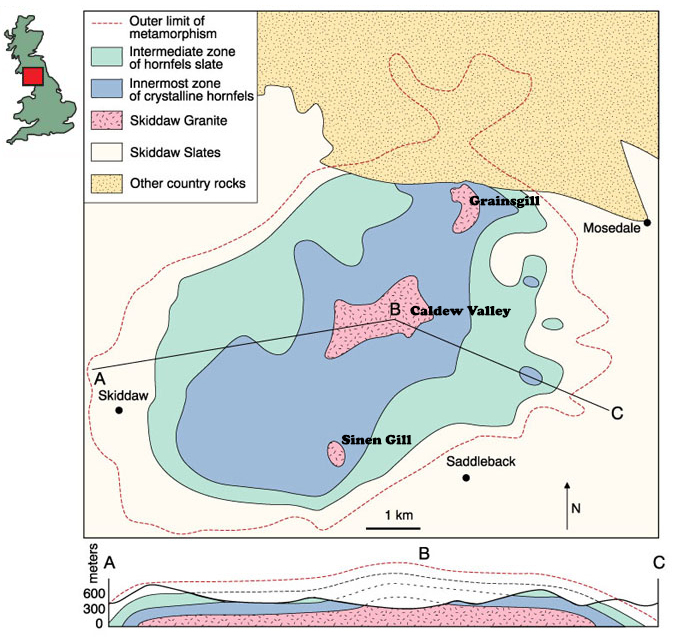Skiddaw Metamorphic Aureole
The Skiddaw Granite (fig. 1), in the northern part of the English Lake District, in the county of Cumbria, is an early Devonian (398±8 Ma; Rundle 1992), peraluminous biotite granite pluton that intrudes folded Ordovician sedimentary rocks of the Skiddaw Group. The Skiddaw Group in this region is dominated by silty mudstones of turbidite origin that show relatively little compositional variation. The roof of the granite is close to the present land surface and exposed (fig. 1) in only three small areas (Grainsgill, Caldew River, Sinen Gill;).
Geologic Map and cross-section of the area around the Skiddaw granite, Lake District, UK. After Eastwood et al (1968).
The intrusion appears to be a steep-sided dome with its long axis approximately N–S. The Skiddaw intrusion is a medium-grained biotite granite comprising orthoclase, oligoclase, quartz and biotite. Accessory minerals include zircon, apatite, ilmenite, pyrrhotite, pyrite, epidote, titanite, anatase, brookite, and rutile. In the River Caldew, feldspars are partially replaced by muscovite as a result of incipient greisen formation, and the biotite is partially replaced by chlorite. The degree of greisen formation increases northwards to Grainsgill where the original biotite granite is pervasively converted to a muscovite-quartz greisen.
The granite is surrounded by a concentrically zoned contact metamorphic aureole nearly 10 km in diameter. The rocks of the Skiddaw Group experienced a regional low grade metamorphism associated with the Caledonian. Toward the granite, these rocks show a classic progression into silty mudstones with andalusite porphyroblasts and/or spots of chlorite/cordierite (andalusite ± cordierite + biotite + chlorite + white mica), to more recrystallized andalusite and cordierite-bearing rocks (cordierite + andalusite + biotite + chlorite + white mica), into crystalline hornfels that locally contains sillimanite closest to the granite (andalusite + cordierite + biotite + white mica ± garnet ± sillimanite).
Outside the contact aureole, the slates have a cleavage which is parallel to the axial surfaces of tight folds. Cleavage and folds are overprinted by the contact metarnorphic aureole, indicating that they belong to a pre-intrusive episode of rock deformation and accompanying regional metamorphism.
Therefore the Skiddaw Aureole shows contact metamorphism superimposed on low-grade regional metamorphism. Microscopic study of the Skiddaw slates outside the contact aureole reveals the mineral assemblages associated with the low-grade regional metamorphism: The phyllosilicate minerals are muscovite and chlorite, with a strong preferred orientation parallel to the slaty cleavage direction. Grains of quartz retaining their original clastic shapes, small prisms of chloritoid and the opaque minerals, pyrite, magnetite and graphite are also present. These are characteristic minerals of aluminiun-rich black shales which have undergone regional metamorphism.
The progressive contact metamorphic sequence in the pelitic rocks of the Skiddaw Aureole is divided into three zones. Increasing metamorphic grade is:
(1) outer spotted slate zone
(2) intermediate porphyroblastic slate zone
(3) inner hornfels zone.
The zones are distinguished on a textural basis rather than on variation in the metamorphic mineral assemblages. The outer spotted slate zone (l) is characterized by a coarsening of the grain size and a tendency for the cleavage surfaces to become more uneven. Spots 0.15- 2.0 mm across, composed of white mica and Chlorite , appear on the cleavage surfaces. In the porphyroblastic slate zone (2), the spots can be identified as porphyroblasts of cordierite and prisms of andalusite (a distinctive variety known informally as chiastolite). The grain size is coarser than in zone (I), and the rocks might be described as fine-grained phyllites. Cleavage is still preserved, but is even more irregular than in zone (I). Andalusite has been replaced by kaolinite with crystals of kaolinite . In the inner hornfels zone (3) the rocks lose their cleavage and become massive, although the cleavage direction may still be visible as banding. The rocks are even textured hornfelses, and not porphyroblastic.
1.jpg)
Skiddaw Granite at Sinen Gill
.jpg)
Skiddaw Granite at Sinen Gill
Bibliography
• David Shelley (1983): Igneous and metamorphic rocks under the microscope. Campman & Hall editori.
• Gray.E Bebout; Derek. C Cooper; A. Don Bradley; Seth J. Sadofsky (1999): Nitrogen-isotope record of fluid-rock interactions in the Skiddaw Aureole and granite, English Lake District. American Mineralogist, Volume 84, pages 1495–1505, 1999

